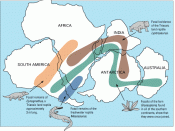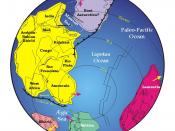Gondwanaland, Science 905 Section I
In the late nineteenth century, on the basis of comparative geological evidence, the Austrian geologist, Edward Suess, founded a theory that a single supercontinent, which he called Gondwanaland, an ancient landmass that consisted of the present continents of South America, Africa, Australia, and Antarctica as well as the Indian subcontinent. Gondwanaland is believed to have been intact at least twice, about 350 million years ago and about 200 million years ago. The more specific date for the beginning of the separation of the continent Gondwanaland is around 245 to 208 million years ago.
Between these two periods all seven of the present-day continents probably formed a single landmass called Pangaea.
Gondwanaland is named after the Upper Paleozoic and Mesozoic formations of the Gondwana district of central India, which display a number of shared geologic features (the "Gondwana beds"). There are also some other evidence such as:
the occurrence of tillites (glacial deposits) of 286 million years ago (the Permo-Carboniferous)
similar plants and animal fossils are found in them but not in the Northern Hemisphere, in particular the widely distributed seed fern Glossopteris
The rocks that contain this evidence are called the Karoo (Karroo) System in South Africa, the Gondwana System in India, and the Santa Catharina System in South America.
The official definition of 'Gondwanaland' is found on the www.thefreedictionary.com site which is as follows:
Noun 1. Gondwanaland - a hypothetical continent that (according to plate tectonic theory) broke up later into India and Australia and Africa and South America and Antarctica
Edward Suess noted that all four continents have similar glacial deposits and fossils corresponding to the end of the Carboniferous Period and the beginning of the Permian Period (about 290 million years ago). However, these glacial deposits and fossils are absent from...


